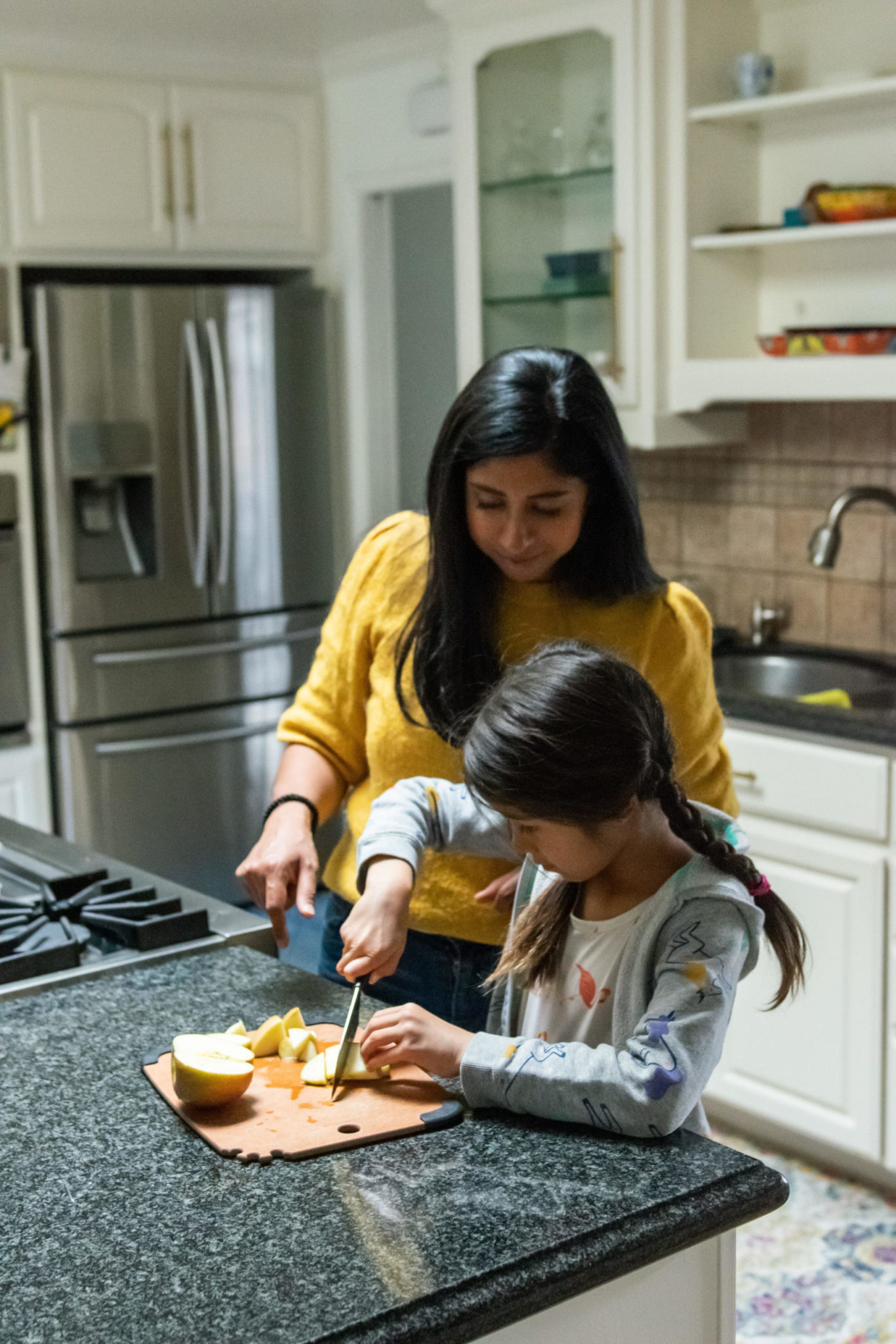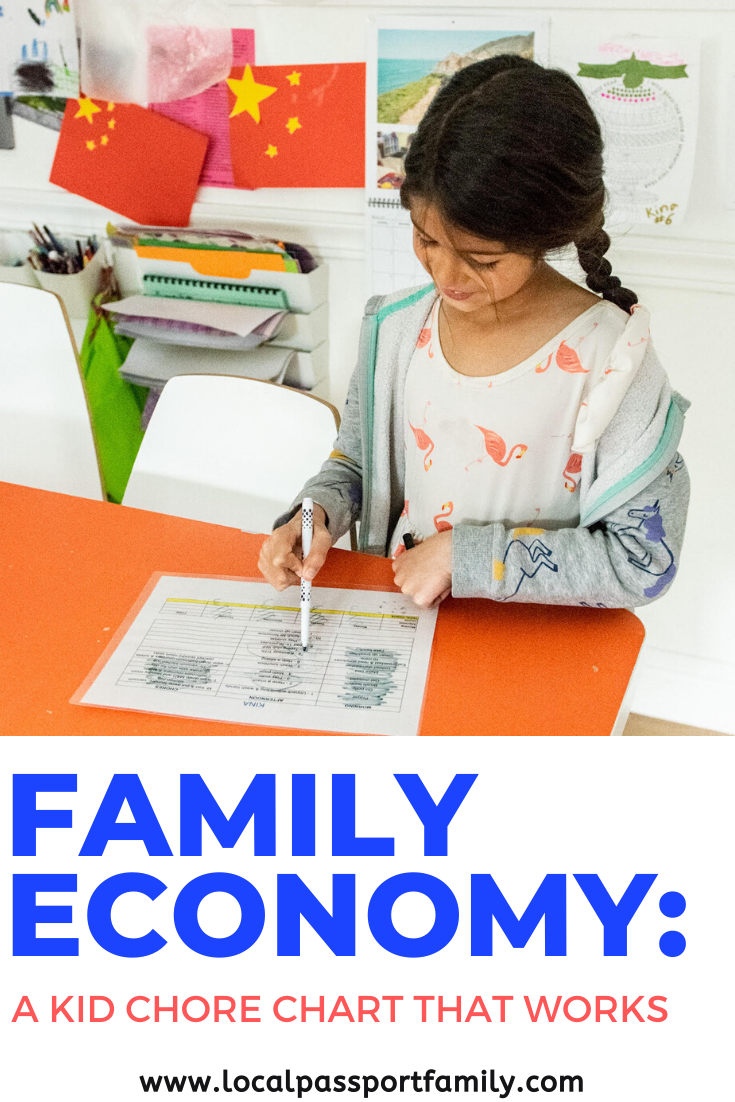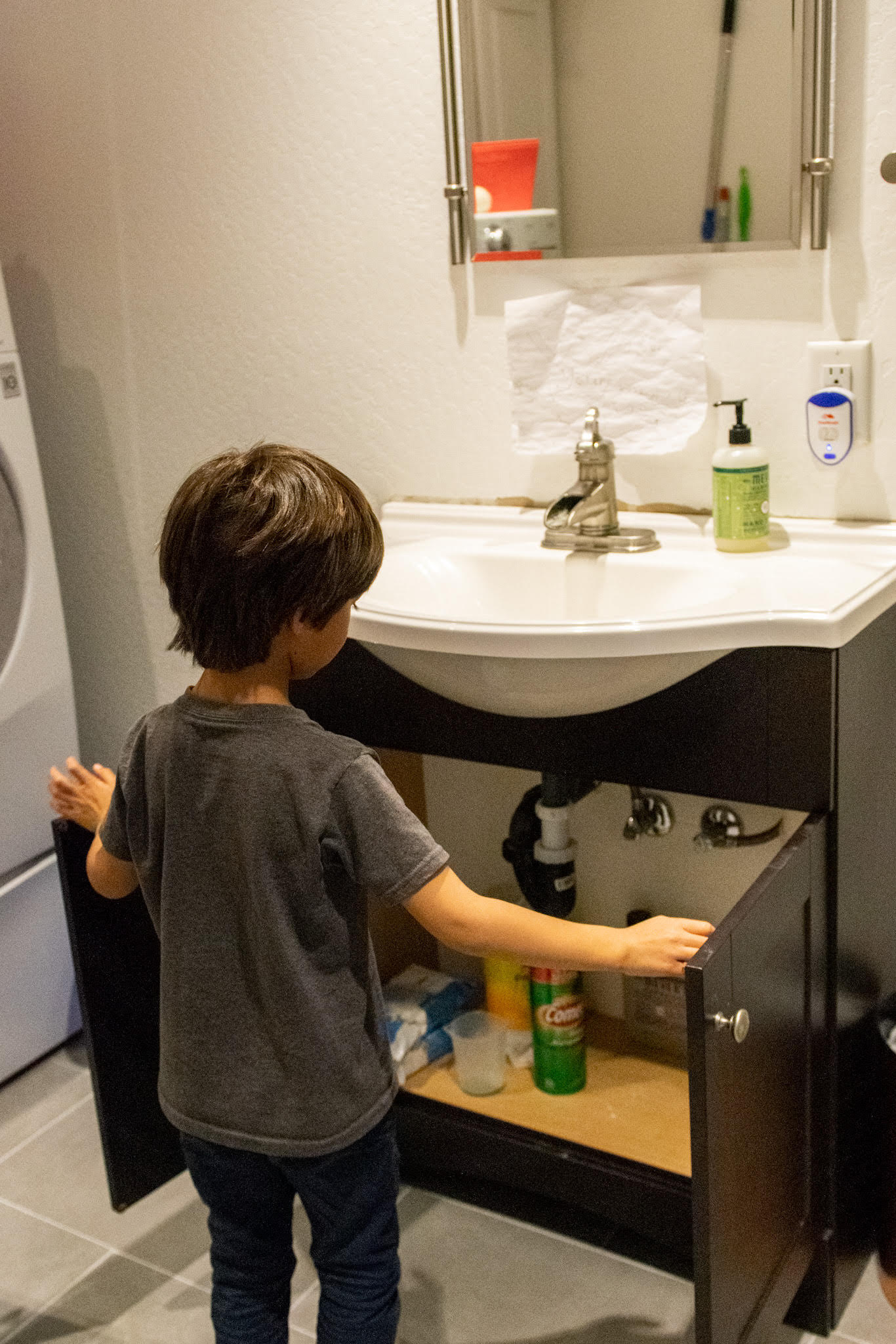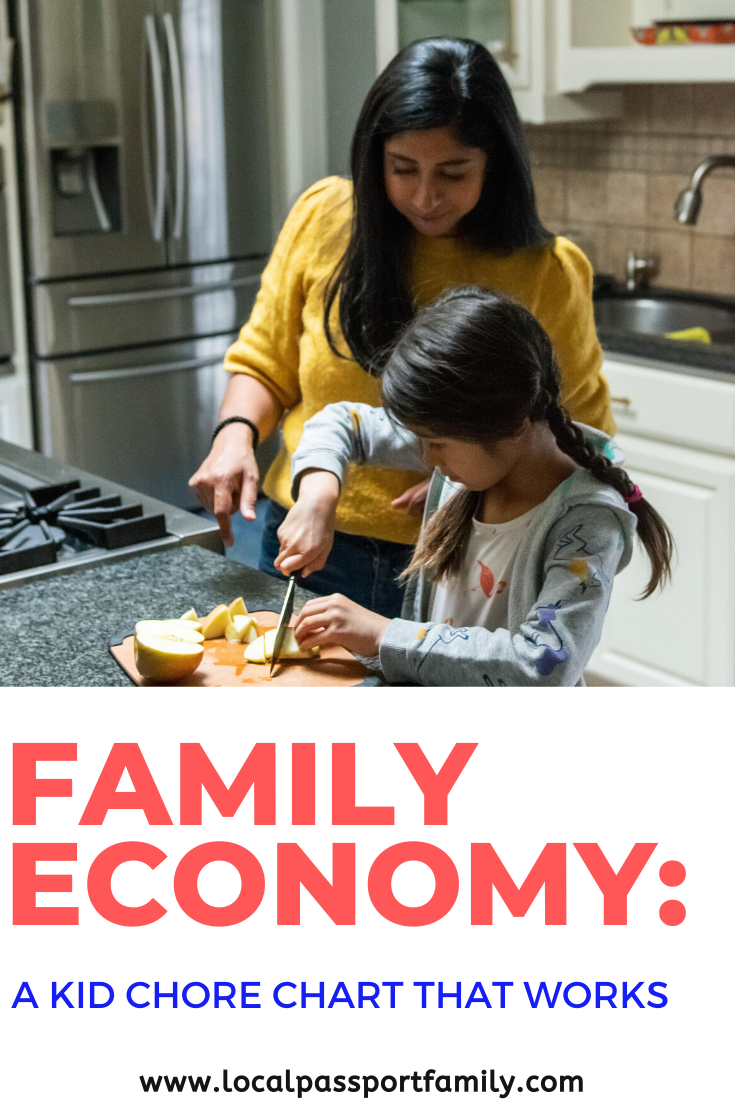Are you tired of nagging your kids to finish their responsibilities? Try implementing a family economy system, a highly motivating kid chore chart that teaches ownership, responsibility, and a strong work ethic. It not only works, but your kids will be proud of all they accomplish!
I’ve written before about our family economy kid chore chart system that we use in our home. It’s been about 2.5 years since we started using it, and while we’ve adapted it a bit, by and large, it’s the same system. And it works.
With everyone at home together for the foreseeable future, it’s even more important to me that everyone contribute in meaningful ways. And with 5 children around all day, every day, I really don’t have the time or energy to nag everyone to get their stuff done. So having a chore chart system that kids can use independently and that is self-motivating is a priority for me.
Of course, with everyone at home right now, the timing on our family economy charts has changed a bit. Still, the overall structure and point system is the same. We just have more time at home to get it done! 😉
Here’s how our family economy system works with our large family!
This post about a family economy chore chart contains affiliate links, but all opinions are 100% my own. That means I earn a small commission if you purchase through my link, but doesn’t change your price.
Table of Contents
Family Economy Update: An Independent Kid Chore Chart
What is a family economy system?
A family economy system is a way for everyone in the family to contribute to family responsibilities, and then manage part of the family resources for their own needs and wants.
Both my husband and I grew up without an allowance, and felt hesitant to give our kids one. We didn’t necessarily want a division of “our” money and “their” money, and I didn’t want to pay them for things I expected them to do, anyway! We did, however, want to teach them financial responsibility and accountability.
The way we structure it is that when our kids take care of a piece of the family’s work, they also get to manage a part of the family’s money. So it’s really rerouting the family money through them to give them ownership over that portion of the “family business.” Semantics, perhaps, but it makes the whole system feel collaborative for us.
What’s the benefit for them?
It definitely took a bit of transition time at first, but our kids quickly saw big benefits. They love being able to decide how to use family economy money! It makes them much more cautious about what they purchase and limits the begging when we go out.
I love being able to answer, “Sure!” when they ask for something, and tell them that they can use their family economy money to purchase it. Then they think through whether they really want to spend money on whatever it is.
The biggest benefits for us is it teaches hard work, connects rewards to effort, and teaches frugality and financial responsibility.
What do they have to do for the kid chore chart? Do you force them to do it?
For the responsibilities tied to the family economy, our kids get to CHOOSE whether they want to participate. This is important. We never force our kids to participate, because that removes the incentive and takes away from the magic of the system being self-motivating. The point is they get to decide whether to participate, which means they also get to choose whether they’ll have funds for their needs and wants.
The responsibilities they get to choose are things like chores (our 9 & 7 year olds make dinner on their own every week!), simple after-school academics (our school has a no-homework policy, so we have time for this), etc. The responsibilities vary by age. You can see them all in our family economy spreadsheet HERE in the “Charts to Print” tab.
I want my kid to help without being paid!
Our kids do have some other responsibilities are some that are non-negotiables and are just part of being in the household. These are mostly basic health and hygiene requirements (like brushing teeth), and things that are requirements for our family to function.For instance, we expect them to load their dishes in the dishwasher because if they didn’t, we wouldn’t have clean dishes the next day. Similarly, if they don’t pack their lunches, they won’t have food at school the next day.
These things are basic requirements for having a functional home. We all clean up the kitchen after dinner so it’s ready for the next day, and the kids put away any toys and crafts so they’re ready for use again. On the other hand, if they don’t do their math page or clean the bathroom, it’s not ideal, but our home will still function. Those are things we’ve found better to officially be part of the family economy (although I have some non-negotiables listed in their charts still, just so they can remember them easily).
Also, I’ve actually found that my kids are MORE likely to help out with other chores around the house since implementing our family economy. They recognize the amount of work it is to run a household, and they learn to contribute to keep everything running smoothly. It’s extremely rare that my kids will flat out refuse to help with a household task.
Do they need reminders for their family economy charts?
Our kids are still fairly young and they’re not perfect so yes, of course they need a few reminders. Especially in the beginning, I had to remind them a lot to get their stuff done.
As time went by, however, they saw how their efforts were directly tied to their rewards. My older two need very few reminders at this point and almost always get their lists done. My 5 year old is still learning to remember on his own, but he’ll get there soon. And instead of needing to nag and say things like, “make your bed!” or “clean the bathroom now!”, I can just ask if they need any checkmarks. If they haven’t yet finished their lists, this usually spurs them right into action.
Similarly, if they’re being slow to get something done (such as setting the table, which needs to be done before dinner), then I can just simply ask the child responsible if they WANT to do it and get their points/money for the day. If they choose not to, it’s fine (although that’s extremely rare). Usually, it just reminds them that they do actually want their money and that the choice is theirs whether to get it. It puts the decision to work and contribute firmly on their shoulders and incentivizes without demanding.
Family Economy Point System: How much money do they earn?
We have our family economy set up on a point system. Each weekday, each child can earn up to 3 points – one for doing their morning list, one for the afternoon list, and one for a chore. This keeps things simple and straightforward.
Each child can earn the same amount of money as their age. So our 9 year old can earn $9/week, our 7 year old $7/week, and our 5 year old $5/week. Their responsibilities increase as they get older so they earn more money.
At the end of the week, if they’ve earned 14 or 15 points, they receive the full amount of money. If they’ve earned 12-13 points, they can memorize a verse of scripture to still earn the full amount of money. If they’ve earned 0-11 points, they can still earn $1 for each day they earn 3 points. This keeps them motivated even if they fall short early in the week.
At the end of each quarter, they earn a 3% compound interest on their savings. This incentivizes them to include extra money in their savings each week. We keep track of their family economy money in this spreadsheet, then transfer the amount to their individual savings accounts each quarter.
What do they use family economy money for?
While we pay for our kids’ extracurricular activities, they pay for any equipment. For instance, if they need a new baseball glove or special paper or a tennis racquet, our kids would pay for that out of their family economy money. This gives them freedom to try new activities without fear of wasting money, but helps keep them invested in the activity.
They can also use their money for any fun activities (e.g., after-school movie events, movie with friends) or for any special toys or treats they want to purchase. Our kids often save up their money to use on vacations.
Our 5 year old recently wanted a bunch of little souvenirs when we were at the Harry Potter land inside Universal Studios. We told him he was welcome to use his family economy money to purchase what he wanted. So he figured out the price on a few things, and decided he wanted a little stuffed Hedwig more than Bertie Botts Beans. He made his purchase and didn’t ask for a single other thing the entire day. He had ownership over his choice and was content with it!
How do they get their money?
I think cash is a pain to deal with, so we track all the money digitally. We have a family economy spreadsheet that we review each Saturday and show them the money they’ve earned. They’re required to put 30% of their money into savings, but can do more if they choose. We highly encourage them to donate 10% of their money to tithing. Then we deduct anything they’ve spent that week and the rest goes into their spending account.
When they want to make a purchase, we just use our credit card after confirming the amount with the child, and deduct that out of their family economy account.
For a short while, we did a coin system with our 3rd where he earned a certain number of quarters each day. This was a good visual for him and needed for our very tactile child. Once he got a better sense for how it worked, we went back to the point system as it’s just less complicated. (No need to have quarters on hand, and easier to deduct expenditures.)
What age should I start a family economy?
This is one of those things that’s going to vary for each child. We first started this system when our oldest was 6 and our 2nd was almost 4. Both did very well with it from the outset.
We started with my 3rd when he was about 4.5, and he took a while to click with it. He’s now a few months over 5 and still needs frequent reminders, but has been much more successful in the last couple months. So if it doesn’t work right away, wait a few months and try again.
Family Economy Chore Chart
HERE Is a link to the exact spreadsheet that we use to track their family economy money. I like using Google Sheets so I can access it anywhere to see how much they have in their accounts. It’s a blank copy, so feel free to save a copy to use for your family. Just click File > Make a copy and save it to your own Google Drive.
There’s also a tab with the the charts we print for them that have their lists. Feel free to edit to include whatever works for your family!
Quarantine Family Economy
With the current quarantine and shelter in place situation, we’re all spending a LOT of time at home together. Thus, it’s even more important for everyone to contribute, and without me constantly reminding them. I’ve never been more grateful for our family economy system.
That said, I’ve included a few other items in their chore task list, as well as reordered some of their other responsibilities. This is more to help them remember to clean up after themselves and look for other opportunities to contribute to our household while we’re all spending so much time here. Feel free to adjust the tasks to whatever best suits your family.
Is family economy still working for you?
At the time of this writing, we’ve been doing our family economy system for about 2.5 years, and it’s still going great! It’s taught my kids to be careful with their money and work hard for it. They are super excited and proud when they use it on something they really want. They are also SO grateful when we purchase a need for them. It’s eliminated a lot of nagging and given them the ownership over their home behavior.
While it takes a bit of time to transition, especially at first, I promise it’s worth it! It’s changed our family and I highly recommend it for teaching financial responsibility to children.
IF YOU LIKED THIS POST ABOUT OUR FAMILY ECONOMY SYSTEM, YOU MIGHT LIKE THESE POSTS TOO:
- 4 Simple Family Dinners Kids Can Make On Their Own
- 15+ Travel Activities for Kids to Explore from Home
- Fun and Simple Homeschool (with lots of outside play)
DON’T NEED A FAMILY ECONOMY KID CHORE CHART QUITE YET? PIN THIS POST FOR LATER!

















How often do your kids earn their full amount? If they miss one thing on the list of 10 does that mean they don’t get a point?
Yes, that’s correct – they need to do everything in the section to earn their point (keeps it simpler to track for me, haha). I’d say in the 2.5 years we’ve been doing it, they’ve earned their full amount at least 90% of the time!
I am having trouble interpreting the spreadsheet. You have three columns “morning,” “afternoon” and “chores.” Do they get points for all columns? What do you mean they need to do everything in their section to receive a point? Everything in “Monday” or everything in “Afternoon?”
Thanks!
Thanks for asking! The way we have it set up, they can get up to 3 points per day – one each for morning, afternoon, and chore. If they do everything in the morning section, they get one check, and so on. Does that help?
[…] included a page or two of these books in our family economy lists […]
[…] aren’t a replacement for their normal family economy daily kid responsibilities, but just some extra fun activities and projects. And obviously, the Global Children’s Book […]
[…] practice is also something I include on my 5-year-old’s family economy list so it’s more likely to happen every […]
[…] it easier for everyone to get on the same page for what needed to happen. Our kids have their daily family economy charts, and I created another simple homeschool schedule with the different responsibilities from school […]
[…] Family Economy: A Kids Chore Chart That Works […]
[…] I love having my 10 & 8 year olds make dinner once a week, and they rotate through 4 recipes each. These recipes are super simple but still filling, healthy, and delicious for the whole family. It’s the perfect addition to our family economy chore program! […]
[…] , localpassportfamily.com […]
[…] , localpassportfamily.com […]
Hi Preethi! I think my 6 and 4 year old are ready to try this out. Been looking forward to starting for over a year 🙂
– Under what conditions are the kids allowed to withdraw from savings?
– You mentioned the kids have to pay for equipment – do you subsidize any equipment? Instruments are pretty costly!
– Where do booklist-level books fall? Very reasonable to expect the kids to buy their own comic books, but are books from your wonderful booklists categorized as a need for the family?
Thank you again so much for writing your blog! I love following all your new posts.
Hooray! I’m glad it’s a good time for you. The kids cannot withdraw from savings – that stays there until they leave home. So they learn to manage how much to keep in their “spending” account.
They only pay for equipment for special things they want to do. We pay for all the instruments, but they would pay for a baseball glove, for instance. We also sometimes gift them equipment for birthdays and such – they tend to really appreciate new cleats or a tennis racquet when they don’t have to pay for them!
They almost never buy books because I purchase a LOT of picture books, haha, and they almost always read chapter books from the library.
Hope that’s helpful!
[…] Family chores […]
[…] our family economy kids’ chore chart if you’d like to see how our family members […]
[…] our family economy kids’ chore chart if you’d like to see how our family members […]
[…] gun, which he’s been asking for ever since his brother bought one using the money from his family economy […]
[…] to accumulate tons of stuff, nor do I want them to feel pressured to spend a year’s worth of family economy money exclusively on gift purchases. And it feels overwhelming and less enjoyable to all of us when we […]
[…] been a couple of years since I’ve written about the best chore chart system for our family: our family economy. […]
[…] Our Family Economy: A Kid Chore Chart That Works […]
[…] Family Economy Kid Chore Chart […]
[…] our family for nearly 6 years, but it’s definitely evolved over the years. Here’s the original post I wrote about our […]
Hey, My question for you is in regards to how you manage their savings and tithing as it’s essentially just coming out of your account and you track everything digitally… So do you give them cash to pay their tithing every so often? And then do you put the money in savings accounts somewhere else for them? Like I understand that if they want to buy something it comes out of your account but do you set that money aside within your own bank account. I budget every dollar and the fact that my kids have just this amount of money technically with me that they can spend anytime doesn’t make sense. So do you have accounts for them that their money is in? How do you manage that. I got the greenlight cards to load money for them so it doesn’t come out of my account everytime. But I don’t know how to manage the tithing and savings portion.. I have been using your spreadsheet and love it. But it still is just money that is in my account and not seperate… therefore I feel like It’s just lie imaginarily being saved. ha
[…] of our kids have certain responsibilities and chores through our family economy system, and they learn young to contribute in meaningful ways. My older two kids make dinner once a week, […]